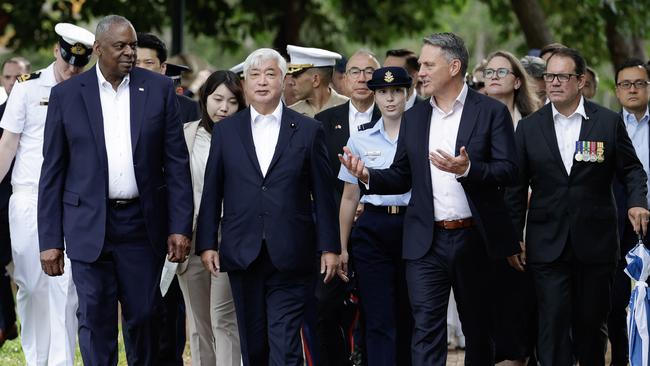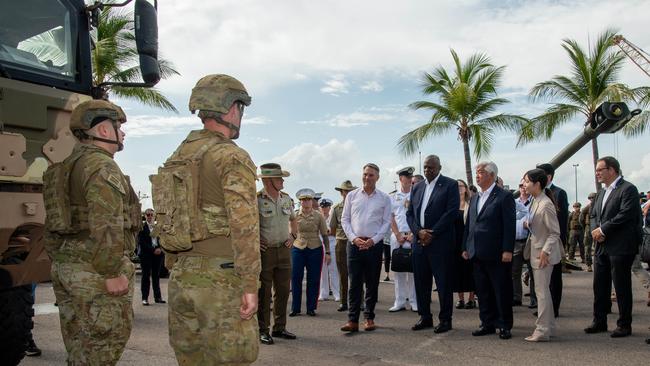Japanese troops to join US Marines for Top End training
Up to 600 Japanese amphibious force personnel will join annual US Marines Corps deployments to the Top End from next year, turbocharging training with Australian Defence Force personnel.

Australia has ramped up security ties with Japan amid growing fears over China’s military might, green lighting annual deployments of hundreds of Japanese troops to Darwin and a new alliance-style agreement with Tokyo and Washington to counter regional threats.
Up to 600 Japanese amphibious force personnel will join annual US Marines Corps deployments to the Top End from next year, turbocharging training with Australian personnel.
Defence Minister Richard Marles announced the measures with US Defence Secretary Lloyd Austin and Japanese Defence Minister Nakatani Gen on Sunday, saying a new formal commitment to consult on regional contingencies would provide “substance and a structure” to the trilateral security partnership.

“It really is a step forward in terms of the way in which the three of us will operate in a collective and co-ordinated way,” Mr Marles said following three-way talks at Darwin’s HMAS Coonawarra naval base.
The commitments came as Mr Austin declared he was confident the US could deliver on its promise to provide Virginia-class submarines to Australia, and Mr Marles confirmed Japan’s Mitsubishi Heavy Industries was one of two remaining contenders to build Australia’s $10bn general purpose frigates.
The inclusion of Japanese troops in the annual dry season troop rotations through Darwin comes more than 82 years after Imperial Japan’s bombing of the city. Mr Marles said the arrangement was an “important statement to the region” on the nations’ resolve to work together to meet security challenges “no matter what that circumstance is”.

As Donald Trump rattles US allies by naming anti-woke Fox News host Pete Hegseth to run the Pentagon, Mr Austin said he was confident the US would to be a “a really reliable and effective ally” to its partners around the world.
Addressing questions over Mr Hegseth’s fitness to lead the Department of Defence, Mr Austin said it was the Trump administration’s prerogative to make its own cabinet appointments.
But he declared pointedly: “This is a large enterprise, the DOD, and it often involves making life-and-death decisions on a near daily basis, and accounting for and taking care of some 2.7 million soldiers, sailors, airmen, marines, guardians, and really remaining focused on protecting the country and protecting our interests around the world.”
Despite the upheaval in Washington, Mr Marles said he expected Mr Trump’s administration to maintain American leadership in the world. “That’s very much part of how President Trump has articulated his message, and that’s what we will expect to see from that,” he said.
He said Australia would be “playing our part” in communicating to the Trump administration about “the issues that are present in our part of the world, in the Indo-Pacific”.
Fresh doubt was thrown over Mr Hegseth’s nomination as a 2017 sexual assault allegation emerged in the US media.
But, days after opposition defence spokesman Andrew Hastie lauded Mr Hegseth‘s appointment, Mr Marles said he had heard only “positive” things about the National Guard veteran and was looking forward to building a relationship with him.
“I think we’ve seen … people coming from a range of different places and perspectives to occupy posts in government. And you know that breadth of experience can be really important,” the Defence Minister said.
US submarine production is languishing at around 1.4 boats a year – well short of the 2.3 per year needed for it to meet its AUKUS commitments without eating into its own requirements. But Mr Austin said investments in production, including a $5bn funding injection by Australia, would “get this done”.
Japan already considers Australia a “quasi ally”, and Mr Nakatani said the new commitments would deepen nations’ security partnership following a reciprocal agreement to streamline joint training.
“The security environment in the region is very severe right now and complex. We need to co-operate from peacetime to contingency,” he said.
In a joint statement the three nations expressed “serious concern about destabilising actions in the East and South China Seas”, including Chinese harassment of Philippines vessels.
Mr Nakatani revealed Japan was looking at deploying its F-35 stealth fighters to Australia’s Exercise Pitch Black next year, while Mr Marles said Japanese and US troops would participate in Exercise PukPuk with Papua New Guinea under a new agreement to include all three nations‘ troops in their respective regional exercises.

Japan’s Mogami frigate is up against Germany’s MEKO design, proposed by TKMS, in the race to build 11 new warships for the navy after South Korean and Spanish rivals were knocked out of the running.
Mr Marles said Australia was “very impressed” with the Japanese ship and would make a decision next year, with the first three vessels to be built overseas and the remaining eight to be constructed in Perth. The US Marine Corps rotational deployments have been under way for the past 13 years. About 2000 marines rotated through Darwin this year, with 200 typically remaining through the wet seasons.
More Coverage






To join the conversation, please log in. Don't have an account? Register
Join the conversation, you are commenting as Logout